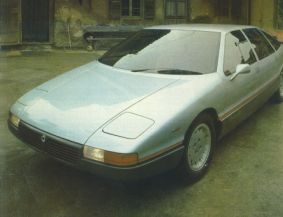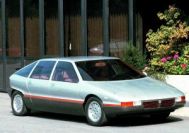|
|
 |
MEDUSA, the 1980 concept car on the Montecarlo platform
|
|
 |
|

|
Giorgetto Giugiaro set new standards in concept and design with the beautiful Medusa in 1980. It was first shown at the Turin Motor Show late 1980. This full four-seater saloon making use of the midship-mounted Beta Montecarlo drivetrain with definitively the almost complete Montecarlo rear end; four doors in a mid-engine car was a very unusual concept! It was a careful aerodynamic design with a Cd value of 0.26 and a wheelbase of 2790 mm, 49 cm more than the Montecarlo. The Medusa never got beyond the concept stage.
According to Wim Oude Weernink, the Lancia authority, who drove the car in 1980: the Medusa was a functional concept car, but without any road manners. The roomy interior and odd yet balanced proportions make it a Giugiaro masterpiece.
Giorgetto Giugiaro, Italdesign (adapted text from VivaLancia,
Lancia Motor Club 2007)
In 1979 he decided to design a car that looked up to date but not
startling, yet incorporated his latest thinking while remaining visually
attractive. He set himself a target Cd of 0.25, which at the time was extremely
low for a production car. Although many concepts and mock-ups had archived
significantly less in the wind tunnel, these were impractical, little more than
styling exercises; the economics and techniques used in production meant that no
mass-produced car had achieved anything like this. To add to the challenge,
Giugiaro insisted that the design was roomy enough to accommodate four in
comfort, and of course roominess and slipperiness are at odds. Giugiaro felt
that the answer lay in rounded forms, an idea that was then prevalent in car
styling.
To show how it could be achieved, late1980 Giugiaro unveiled the Medusa
with a Cd of 0.263, the car that incorporated all of his philosophy. The clay
model actually achieved a Cd of 0.255 but when it came to building the car,
additions like wing mirrors, a radiator, indicator repeaters and ventilation
network caused it to register a higher reading. Even so it had the distinction
of being the most aerodynamic saloon in the world, using production mechanicals.
Today it looks commonplace, but this is because so many of its features and
styling cues have been copied; in 1981 everybody wanted to know more. Foremost
among them was John Delorean, who went on to use Giugiaro for a number of
projects including of course, the DMC 12. But one thing that has never been
copied and remains unique to the Medusa is the big indentation/ scoop along the
side above the bumpers.
| Photos Julian Maddison | |
Giugiaro achieved his goal by starting with a largely elliptical outline,
and using very rounded lines throughout, something that contrasted with his
earlier use of sharp lines and hard edges. The car was very low at 51 inches,
lower than a Citroen CX which for
many remained the benchmark, but with a much cleaner profile than the French
offering. At 14' 3" long and 69 inches wide it was also smaller than
the CX. It's still an attractive car, and few would know that it was based entirely on the Beta
Monte Carlo. Yet for all the emphasis on 'roundness' there are many
straight lines and sharp edges to give it dynamism (especially the window in the
C-pillar which is triangular and connects the level of the waist-line to the
higher rear spoiler). Apart from the necessary door mirror (itself the optimum
shape and in the optimum position) there were hardly any external protrusions
whatsoever. The door handles lay flush, there were no rain channels, indicator
repeaters were inset in the front wings, and the windows lay flush with their
frames and the doors rolled gently upwards into the roof for the smoothest
possible shut lines. This was a Giugiaro innovation and this type of door (viz.
cuts into the roof) was quickly christened 'the autoclave'. It was later used by
Giugiaro in production for the Fiat Uno, Nissan Micra Mk I, Renault 21, Saab
9000 / Lancia Thema / Fiat Croma, and the Isuzu Piazza. Pininfarina adopted this
principle for the Alfa 164 and Bertone used it for the Citroen XM, while Fiat, and IDEA used it for the Tipo and Tipo based cars
such as the Alfa 155 and 145.
The bonnet had a tiny lip at the trailing edge to deflect air up the
windscreen and over the (surprisingly small) roof. Even the wheels were designed
with airflow in mind. But the biggest aerodynamic aid wasn't in the detail; it
was simply that the lower section of the bodywork was slightly wider than the
upper half. Doing this achieved a number of things in one stroke. First it
helped aerodynamic efficiency in its own right. Secondly it eliminated the need
for wheel protection (thus no wheel arch lips or bulges) and thirdly it masked
the fact that the chassis rails had been significantly spread to increase
passenger room. The profile of the car rises from its low nose to its slightly
kicked up tail, and (if you include the bumper sections) runs unbroken along the
whole length the car, meaning that wake distortions were all but eliminated.
There was no front spoiler - just a vestigial lip, and an undertray made sure
the underside of the car was smooth and unobstructed. Where possible lightweight
materials were used. The essential bodywork structures formed the door openings
and front and rear pillars, and the doors latched directly to the bodywork.
Everywhere possible, panels were laid flush and butted up very close to each
other, even the leading edge of the roof rolled gently down to the screens.
Giugiaro claimed that with some minor tweaks he could easily achieve his
0.25 target, especially if he ditched the mid-engined Montecarlo layout and went
for a front-engined configuration, even though that would demand a longer nose.
Giugiaro in fact considered using a Beta Coupe as the basis for the Medusa but
felt it was politically inappropriate, because it might look as if he were
suggesting the Beta's replacement. It was probably for similar
reasons that the Medusa never made it into production, but it created a
sensation, and generated an inordinate number of inquiries. Elements of it
appeared in many subsequent Italdesign models, and if its lines have since
become familiar, this is because so many elements of its design cues have
cropped up time and again in European and Japanese saloon cars. Still, they say
that imitation is the sincerest form of flattery and in terms of getting the
message across it achieved its objective. It remains a fascinating and
significant car, one that Italdesign (and Giugiaro in particular) always include
in their list of significant milestones, and one which they regularly refer to
and quote. At one stage it was virtually permanently on display somewhere but it hasn't been seen for a while, though
it was recently in the Mito-macchina exhibition in Rovereto. Having done its
job, where is it now?
Latest news:
The MART museum in Rovereto, Italy had a special exhibition for special car designs in the early months of 2007. Among the 70 cars displayed was, of course, the Medusa.
In March 2008 the Medusa was on display with Giugiaro at the Geneva Motorshow.
|
||||||||||||
| Pictures taken by Chris Ice at the Monterey weekend August 2001 |
| Back to Home Page |
© Arnoud Coenen, NL. January 2009